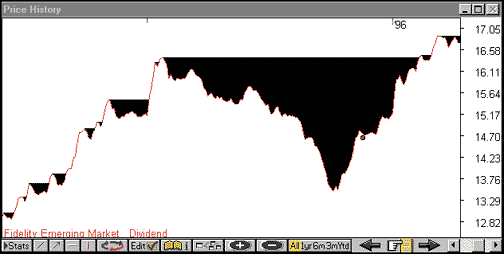MUTUAL FUNDS
The Ulcer Index
by Gary H. Elsner, Ph.D.
A good risk index can be useful in the selection of stocks, funds, and trading systems. Here, then, is the ulcer index, why it is superior to the standard deviation statistic, and how it can be used in a variety of personal investing or professional money management applications.

The standard deviation may still be the most widely used because it has been around longer than other risk indices and most computer programs have the capability of calculating it. However, there is another measure of risk, superior to the standard deviation: the ulcer index.FIGURE 1: FIDELITY EMERGING MARKET. The ulcer index uses only the retracements from the price peaks (the shaded areas) in the calculation.
Peter G. Martin and Byron B. McCann are credited with the creation of the ulcer index. They describe it in their 1989 book, The Investor's Guide To Fidelity Funds. (To see the calculation for the ulcer index, see the sidebar "The ulcer index.") In contrast to the standard deviation, the ulcer index has none of the aforementioned weaknesses since it calculates retracement, which is the tendency for values to fall from previous highs, by measuring the depth of the drop and the time that it takes the performance measure to recover to the original level.
Another advantage is that the ulcer index doesn't measure downside changes from the average but from the previous high. For example, in Figure 1, all of the shaded areas are included in the calculation of the ulcer index. The measurement includes every drop in performance in the period being studied. Funds or trading systems with high ulcer index readings should be avoided unless they have such exceptionally high returns that the risks are justified. In addition, dividing returns by the ulcer index produces a useful risk-adjusted return measurement.